
Creating an App with ChatGPT
Do you want to make an app with ChatGPT and earn lots of money? Here’s what you should understand.

Let’s address the tough truth upfront. If you believe ChatGPT can create an iPhone app with in-app purchases that will earn you a million dollars, I’m sorry to say, but that’s not the case.
I’m bringing this up because every time I discuss building products, there are some individuals who either (a) hope I’ll write them a million-dollar app, (b) wish for a single class or book to magically teach them how to make a million-dollar app, (c) seek a hidden tool or program that millionaire programmers use, or (d) request an introduction to my programmer friends, thinking one of them will create a million-dollar app for them without hesitation.
The software industry doesn’t operate like that. Software is incredibly complex and vast. Many apps depend on connections to extensive networks of resources that must be seamlessly integrated. In essence, numerous apps are just user-friendly interfaces for massive computing systems that perform their tasks behind scenes.
Other apps, like games, for example, require teams of individuals with a diverse set of skills collaborating harmoniously, often over years, to develop a successful app.
Ways in which ChatGPT can assist in app development
I’m confident that ChatGPT can assist you in app development. However, it won’t handle the majority of the work – that’s your responsibility, along with your team. Nonetheless, it can potentially save you time and significantly decrease the effort required. And that’s a victory in itself.
With that in mind, let’s explore how ChatGPT can aid in the app creation process.
1. Plan your app
There are approximately 2 million iPhone apps and around 3.5 million Android apps out there. Finding a unique app idea can be challenging, and it’s generally not a good idea to create something with tons of competitors.
While ChatGPT can be a valuable resource for research, it’s essential not to rely solely on it. You can involve ChatGPT, asking questions like, “Are there iPhone apps that count the days until retirement?”
However, keep in mind that ChatGPT’s knowledge only goes up to 2021. So, if you plan to develop an app related to current trends, ChatGPT might not be aware of what’s in the app store. Google’s Bard, on the other hand, could provide more up-to-date information.
For instance, when I asked ChatGPT, it replied, “There are no specific iPhone apps designed for this purpose,” while Bard responded, “There are a few iPhone apps that can help you create ChatGPT prompts,” and listed them.
Another option is to consider using ChatGPT Plus. ChatGPT Plus, which costs $20 per month, offers access to plugins, including WebPilot. With the WebPilot plugin enabled, ChatGPT can search the web.
This provides access to more recent information. You might need to refine your queries, but you’re no longer limited by the knowledge cutoff date of 2021.
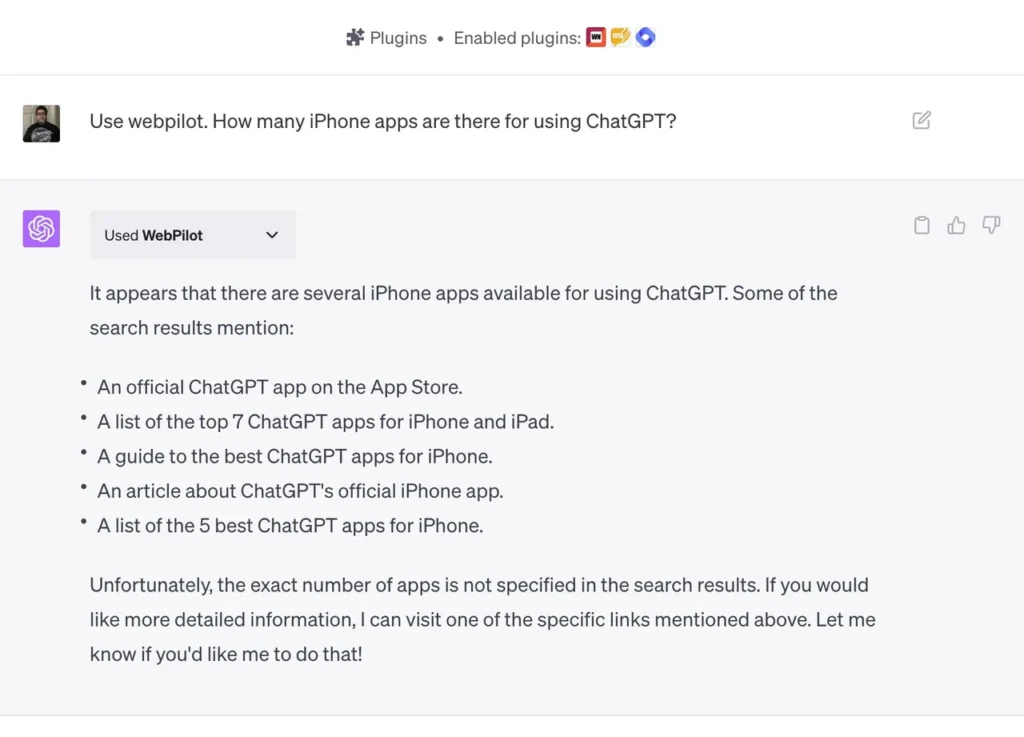
Planning your app involves more than just basic market research. You’ll want to carefully consider functionality and features, as well as design a user interface mockup. Let’s continue with the idea of building an app that assists in creating ChatGPT prompts. You can ask ChatGPT:
“I want to build an iPhone app to help write ChatGPT prompts. What should the major and minor features be in such an app?”
I recommend typing this into ChatGPT because the response it provides is remarkably comprehensive. It demonstrates how ChatGPT can be genuinely helpful in the app development process.
Moving on to the user interface, while ChatGPT can’t draw wireframes, you can ask it to guide you in creating the main screens. For example, you can ask:
“Can you describe the screens and user interface elements this app should have?”
Again, I suggest running this prompt, as the AI tool’s answers are surprisingly well-thought-out.
Once you have your app idea and have planned some elements, you’ll need to consider development and deployment. You might try a prompt like this:
“I want to build this app. What do I need to do to start development and prepare for deployment?”
The answer may be a bit general, but it can be helpful for someone new to the process. You can then go deeper with questions like:
“Help me set up and configure the Xcode development environment to write this app.”
Or even more specific:
“Help me choose a template and configure the Xcode settings for my project. Also, how should I configure Interface Builder?”
This can provide valuable guidance. Keep asking questions, adding elements to your project, and feel free to seek assistance from ChatGPT along the way. However, remember that there’s a wealth of help for app development beyond AI. Don’t hesitate to use traditional web searches to find examples and guides. App development is a substantial project, and you should utilise all available resources.
2. Build your app
This is the stage where you get down to the nitty-gritty of developing your app, where code meets the development environment. ChatGPT can provide specific assistance in this crucial phase.
To be clear, we’re not at the point where you can simply instruct an AI tool to create an entire app for you. Apps are complex, often consisting of hundreds of thousands or even millions of lines of code spread across numerous files. ChatGPT currently doesn’t handle that level of scope.
To put it in perspective, think of an app as a book or even a collection of books, and a function, method, or subroutine as a paragraph, a short article, or a chapter within those books. ChatGPT can assist you at the paragraph level, helping you structure individual parts of app, but it doesn’t know how to create entire book.
However, it can still be incredibly helpful. Earlier, I demonstrated how it can assist in defining user interface elements. You can use ChatGPT to give you precise instructions for putting these elements together. For instance:
“Explain how to set up outlets and actions to initiate a search for a prompt in an existing set of saved prompts.”
This prompts the AI to explain how to set up a specific function in the user interface. You can use similar requests for different elements in your user interface or to create specific functions or set up data elements. For example:
“Help me configure a storage mechanism for saved prompts.”
“Walk me through using Core Data to save prompts for later access.”
By using these instructions, you can receive guidance and even some initial code to get started with the data storage mechanism.
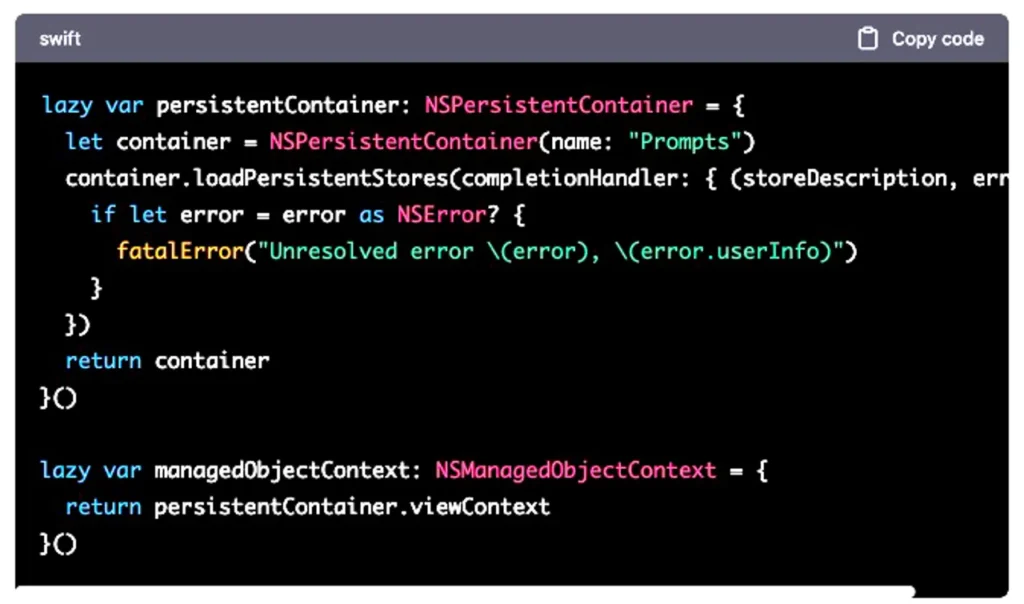
The code examples provided by ChatGPT can serve as valuable starting points for your app development. You can use these code snippets as a foundation and build upon them with your own code. With ChatGPT’s assistance, you have a solid starting point to work from, which can save you time and effort in the development process.
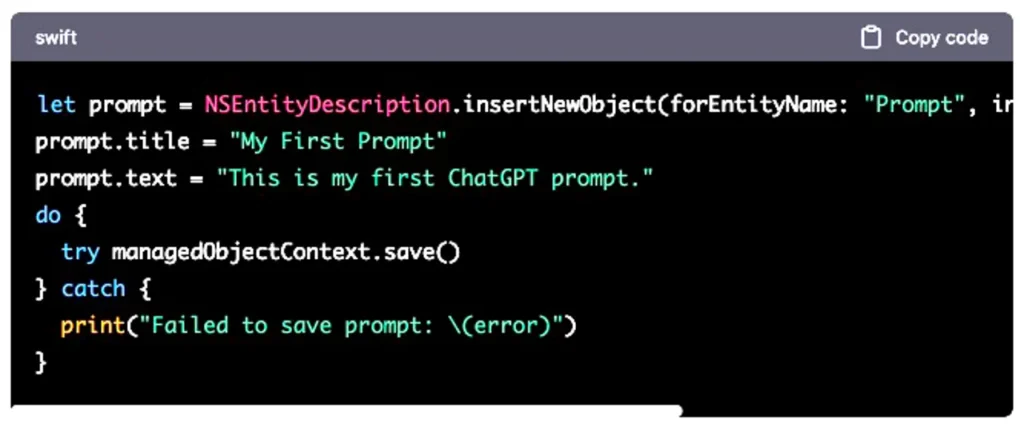
Retrieving a prompt is a crucial step in your app’s functionality, and the code example from ChatGPT can guide you on how to accomplish this. You can use the provided code to fetch the data and then format and present it according to your app’s user interface design. This flexibility allows you to customise the presentation while leveraging ChatGPT’s assistance for the core functionality.
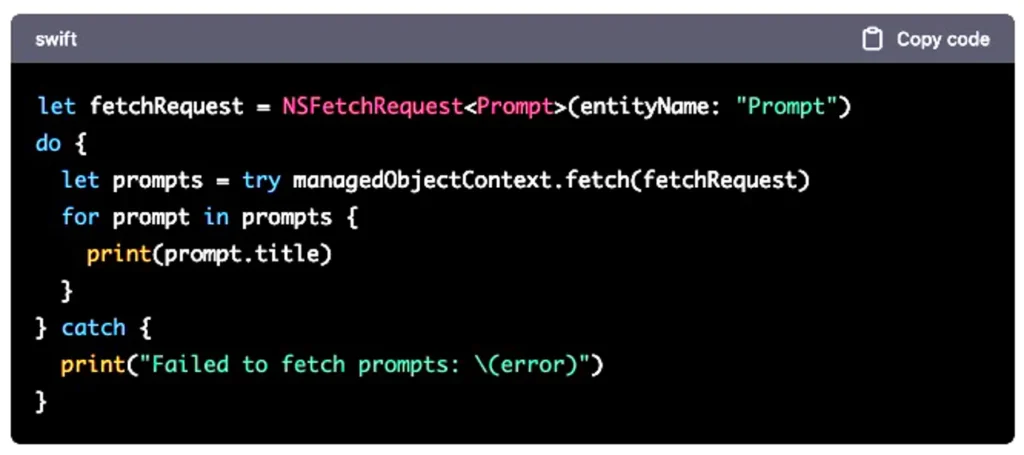
You’ve got the right approach in using ChatGPT to assist with small, well-defined pieces of code and provide guidance. Think of it as having a skilled junior developer who comprehends code but might not grasp the entire app’s structure.
And you’re spot on regarding the expectations. Not all of ChatGPT’s code will work flawlessly, just as code created by human developers varies in quality. It’s important to thoroughly test and debug the code generated by ChatGPT and be prepared to make necessary adjustments.
The AI can be a valuable tool, but human oversight and expertise are still essential in the development process.
3. Deploy your app
The procedures for deploying an app are quite similar across different platforms, and ChatGPT can assist you in navigating this process effectively. To start, you can issue a prompt like this:
“Walk me through the steps necessary to deploy my app.”
When I asked ChatGPT, it provided these six steps, along with a concise summary of each:
- Register for an Apple Developer account.
- Configure your app’s settings.
- Prepare your app for distribution.
- Submit your app to the App Store.
- Wait for app review.
- Release your app.
You can extract even more value from ChatGPT by delving into the details of each of these steps. For instance:
“Tell me precisely how to configure my app’s settings for deployment.”
“Tell me precisely how to submit my app to the App Store.”
Keep drilling down and ask for clarification if there are steps that ChatGPT doesn’t fully cover. Think of it as a persistent pursuit, similar to questioning a witness in a courtroom until you obtain the information you need.
Whether your app is unique and thriving or you’re managing customer support, debugging, and planning your next steps, reaching this stage is an achievement. Back in the day, I developed 40 small iPhone apps, and ChatGPT would have certainly been a valuable resource.
Just remember to view it as one tool among many in your toolkit, not the only tool, and you’ll navigate the app development journey successfully.
Some FAQs
Which is the preferred choice: developing an iPhone app or an Android app?
Both the Android and iOS markets are substantial, and if your app gains success, you’ll likely want to deploy it on both platforms. However, the choice of platform can depend on the specific functionalities and goals of your app.
For example, some apps may be better suited to one platform over the other. If you’re developing an app with advanced customisation options for Android users, similar to Tasker, then focusing on the Android platform makes sense.
In general, it’s advisable to start with the platform you are most comfortable with and build your app there. Once your app is established and successful on one platform, you can consider expanding it to the other platform.
This approach allows you to leverage your existing expertise and resources while ensuring a smoother development process.
What steps can I take to ensure my app appears in search results effectively?
When it comes to improving your app’s visibility in the app store, a combination of keyword optimisation and appealing graphics is essential. Start by ensuring that your app has an eye-catching icon and includes an adequate number of screenshots and videos. These visual elements play a crucial role in attracting potential users.
For optimising search results and discoverability, you’ll need to focus on SEO (Search Engine Optimisation) within the app store. It’s crucial to identify the right keywords that can help your app stand out among the competition.
Various tools are available to assist you in this endeavor, and you can ask ChatGPT for recommendations & guidance on how to effectively implement these strategies.
With which programming languages can ChatGPT provide assistance?
ChatGPT’s versatility in handling various programming languages, both common & relatively obscure or obsolete,a testament to its extensive knowledge & capabilities.
While there might be some languages not covered in its library, for common mobile development languages, it’s likely to provide valuable assistance and support.
This makes ChatGPT a valuable resource for developers working with a wide range of programming languages.
What is the typical timeframe for developing an app?
The time it takes to develop an app can vary significantly, ranging from a week to three years. The timeline depends on various factors, including the app’s complexity, its goals, level of experience of you & team, & other considerations.
For example, building a relatively simple app might take a few months to a year, whereas more complex projects, such as creating a social media platform like Facebook or large-scale applications like Instacart or Uber, can span several years.
It’s essential to assess the specific requirements and goals of your app to estimate the development timeline accurately.
Never miss any important news. Subscribe to our newsletter.
Related News


British Investor Who Predicted US Slump Warns of Next Crash

I’m a Death Doula: 4 Reasons I Believe Death Isn’t the End


Tech to Reverse Climate Change & Revive Extinct Species

AI Unlocks the Brain’s Intelligence Pathways

XPENG Unveils Iron Robot with 60 Human-like Joints

Can AI Outsmart Humanity?

11 ChatGPT Prompts to Boost Your Personal Brand

Keir Starmer Hints at Possible Tax Hikes on Asset Income
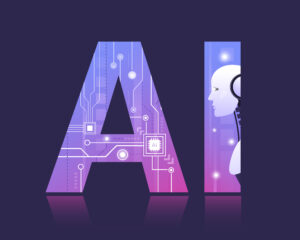
Navigating the Future of AI: Insights from Eric Schmidt
